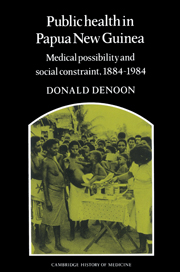Book contents
- Frontmatter
- Contents
- Acknowledgements
- Maps of Papua New Guinea
- Introduction
- I The rise and fall of tropical medicine
- II The rise and fall of the great campaigns
- 8 Miracle drugs, new perceptions and the post-war Public Health Department
- 9 The health campaigns
- 10 Women and children last
- 11 Health education
- 12 A national health system
- 13 Primary health care
- 14 The past and the future
- Notes
- Bibliography
- Index
9 - The health campaigns
Published online by Cambridge University Press: 11 February 2010
- Frontmatter
- Contents
- Acknowledgements
- Maps of Papua New Guinea
- Introduction
- I The rise and fall of tropical medicine
- II The rise and fall of the great campaigns
- 8 Miracle drugs, new perceptions and the post-war Public Health Department
- 9 The health campaigns
- 10 Women and children last
- 11 Health education
- 12 A national health system
- 13 Primary health care
- 14 The past and the future
- Notes
- Bibliography
- Index
Summary
Although most of the personnel were new, and conscious of making a new beginning in public health, in one respect at least they persisted in old habits. Most of the activity of the department was correctly described as a series of assaults on specific diseases. The purpose of Gunther's survey of before he assumed the Directorship, was to identify the ‘killer-diseases’ which posed the most serious threats to health, and which were most amenable to treatment. His exasperation during the first years of his office was the shortage of personnel to attack the diseases which he had targeted. In retrospect this may seem to have been a strategic error; but the approach was shared by public health authorities throughout the world, and war-time habits of thought easily seduced medical workers to see specific disease as the enemy. During the 1950s that mind-set was, if anything, reinforced. Counter-insurgency campaigns during the 1950s often endorsed the medical image of communism and nationalist revolt as unnatural infections to be contained and eradicated by heroic effort. To be sure, the excitement of campaigning against specific diseases did wonders for the morale of ex-servicemen doctors, and evoked heroism in their work. Perhaps no other strategy could have been so readily understood by the medical workers, nor so enthusiastically implemented.
- Type
- Chapter
- Information
- Public Health in Papua New GuineaMedical Possibility and Social Constraint, 1884–1984, pp. 77 - 84Publisher: Cambridge University PressPrint publication year: 1989



